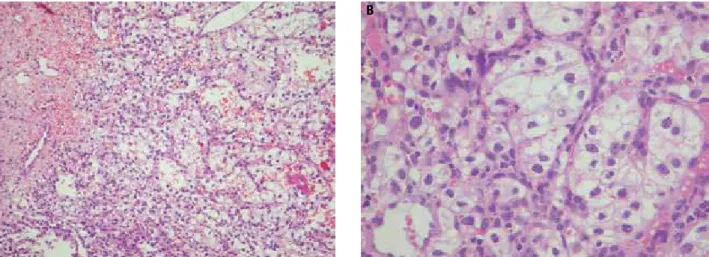Cop
yright
© ABE&M t
odos os dir
eit
os r
eser
vados
.
Arq Bras Endocrinol Metab. 2010;54/5 498
clinical case report
Pituitary gland metastasis from
renal cell carcinoma presented as
a non-functioning macroadenoma
Metástase de carcinoma de células renais para hipóise simulando macroadenoma não funcionante
Caroline Kaercher Kramer1, Nélson Ferreira2,
Sandra Pinho Silveiro1, Jorge Luiz Gross1, José Miguel Dora1, Mirela Jobim de Azevedo1
SUMMARY
Metastatic tumors involving the pituitary gland are an uncommon inding and occur in up to 1% of all pituitary tumor resections. A 74-year-old man had progressive vision deterioration, over the 30 days prior to consultation. He did not complain of headache or polyuria, but referred to intestinal constipation. Five years ago, he underwent a right radical nephrectomy for renal cell carcinoma, followed by chemotherapy and radiotherapy for lung and parotid metastases. On ophthalmologic examination, there was a left abducens nerve palsy and bitemporal hemiano-pia. Magnetic resonance imaging demonstrated a sellar mass with suprasellar cistern extension compressing the optic chiasm. Endocrinological evaluation revealed central adrenal and gona-dal insuficiencies. The patient underwent a transsphenoigona-dal tumor resection that revealed renal cell carcinoma. This case illustrates that metastatic pituitary lesions can mimic typical symp-toms and signs of pituitary macroadenoma. Furthermore, clinical diabetes insipidus, a common inding of pituitary metastases, can be absent. Arq Bras Endocrinol Metab. 2010;54(5):498-501
SUMÁRIO
Metástases de neoplasias para hipóise são incomuns e ocorrem em até 1% dos tumores de hi-póise. Apresentamos o caso de um homem de 74 anos de idade com progressiva deterioração visual nos 30 dias que antecederam seu atendimento. Ele negava cefaleia ou poliúria e queixa-va-se de constipação intestinal. O paciente havia sido submetido à nefrectomia radical para car-cinoma de células renais cinco anos antes, seguida de quimioterapia e radioterapia por metásta-ses pulmonares e parotídea. Ao exame oftalmológico, apresentava paralisia do nervo abducente esquerdo e hemianopsia bitemporal. A ressonância magnética demonstrou uma massa selar com extensão suprasselar comprimindo o quiasma óptico. Na avaliação endocrinológica apre-sentava insuiciência adrenal e gonadal centrais. O paciente foi submetido à ressecção transes-fenoidal da lesão que, ao exame anatomopatológico, se revelou como carcinoma de células renais. Esse caso demonstra que a presença de lesões metastáticas na hipóise pode mimetizar sinais e sintomas de macroadenoma não funcionante e que odiabetes insípidocentral, comum nas lesões metastáticas para hipóise, pode estar ausente. Arq Bras Endocrinol Metab. 2010;54(5):498-501
1 Serviço de Endocrinologia,
Hospital de Clínicas de Porto Alegre, Universidade Federal do Rio Grande do Sul (UFRGS), Porto Alegre, RS, Brazil
2 Serviço de Neurocirurgia, Hospital
São José, Complexo Hospitalar Santa Casa de Misericórdia de Porto Alegre, Porto Alegre, RS, Brazil
Correspondence to: Caroline Kaercher Kramer Serviço de Endocrinologia do Hospital de Clínicas de Porto Alegre Rua Ramiro Barcelos, 2350, Prédio 12, 4º andar
90035-003 – Porto Alegre, RS, Brazil
carolinekkramer@gmail.com
Received on Dec/20/2009 Accepted on Mar/29/2010
INTRODUCTION
M
etastatic tumors involving the pituitary gland is an uncommon inding and occurs in up to 1% of all pituitary tumor resections (1) and in 0.14 to 28% of all brain metastases in autopsy series (2-3). We present a case of a renal cell carcinoma metastatic to the pituitary gland and a brief review of the literature.CASE REPORT
chemothe-Cop
yright
© ABE&M t
odos os dir
eit
os r
eser
vados
.
499 Arq Bras Endocrinol Metab. 2010;54/5
Pituitary metastasis from renal cell carcinoma
rapy for lung and parotid metastases were performed and 2 years later radiotherapy for lung metastases was conducted. A total thyroidectomy had been performed six years before, because of a multinodular compressive goiter and the patient has been using 100 μg/day of levotiroxine since then. On physical examination heart rate was 84 bpm, blood pressure 120/70 mmHg, and 115/66 mmHg, respectively at recumbent and standing positions. His skin was pale and dry, and Achilles tendon relexes were blunted. On ophthalmologic examination, there was a left abducens nerve palsy and bitemporal hemianopia. No abnormalities were observed on geni-talia examination. Magnetic resonance imaging (MRI) demonstrated a 1.2 x 0.9 cm sellar mass with suprasellar cistern extension compressing the optic chiasm. Pre-contrast T1-weighted images showed intermediate ho-mogeneous isointense signal and heterogeneous signal in T2-weighted images. After gadolinium infusion there was a heterogeneous enhancement, suggesting a highly vascular content (Figure 1). Endocrinological evaluation revealed pituitary insuficiency as follows: serum ACTH < 10 pg/mL [reference range (RR): 10-52] and cor-tisol values of 0.6, 6.1 and 3.9 µg/dL at 0, 30 and 60 minutes after i.v. cortrosyn 1 µg; serum testosterone < 12 ng/dL (RR: 280-1100); FSH 2.5 ng/dL and LH < 0.7 ng/dL. Prolactin values were slightly increased [32 ng/mL (RR: 3-19)] and growth hormone axis [IGF-1 150 ng/mL (RR: 79-290)] seemed to be unaffected. Free T4 was 0.8 ng/dL (RR: 0.7-1.9) and TSH was 0.14 µUI/mL (RR: 0.3-6.5). Serum sodium and po-tassium were 142 mEq/L and 4.5 mEq/L, respectively. Hemoglobin was 11 g/dL. A visual threshold ield test showed a progressive bitemporal hemianopia on serial evaluation 2 months apart, due to tumor compression. The patient underwent a transsphenoidal tumor resec-tion due to progressive visual loss and the histological examination of the tumor revealed renal cell carcinoma with rich vascular content (Figure 2). The study protocol was approved by the ethics committee of the hospital, and consent was obtained from a relative of the patient.
DISCUSSION
This is the case report of a 74-year-old man with a vious nephrectomy for renal cell carcinoma who pre-sented progressive visual loss and a 1.2 cm sellar mass compressing the optic chiasm in MRI. Central hypoa-drenalism and hypogonadism were present, and surgi-cal resection disclosed a renal cell carcinoma metastatic to the pituitary gland.
Figure 1. Magnetic resonance imaging demonstrating the compression of the optic chiasm (white arrows) by the pituitary metastasis of renal cell carcinoma, with heterogeneous enhancement after gadolinium infusion.
Virtually any tumor can metastasize to the pituitary gland, but breast and lung cancer are the most preva-lent, accounting for two thirds of the cases (4). At pre-sentation, most are widespread tumors with multiple site implantation, and mainly involving elderly patients (5-6) . Despite the association with breast cancer there does not seem to be any gender predominance (7).
Secondary spread of renal carcinoma was previous-ly described in 2.6% of metastatic pituitary lesions in a series of 360 cases (4). In another study of 88 cases of pituitary metastatic lesions there was no case of metas-tatic spread of renal carcinoma (8).
Cop
yright
© ABE&M t
odos os dir
eit
os r
eser
vados
.
500 Arq Bras Endocrinol Metab. 2010;54/5
Pituitary metastasis from renal cell carcinoma
A B
Figure 2. Histological examination of the pituitary tumor: hematoxylin-eosin stain 40x (A) and 100x (B) showing the highly vascular content of renal cell carcinoma.
mainly supplied by the hypophyseal portal system. The-refore, the presence of diabetes insipidus, the rapid pro-gression of symptoms, and the presence of cranial neu-ropathy favor a diagnosis of metastases over pituitary adenoma. A left abducens nerve palsy was observed in the present case, but there was no evidence of diabetes
insipidus. Diabetes insipidus occurred in 45.2% of the
cases in a series of 190 patients with symptomatic pitui-tary metastases (4) and, in another series of 36 cases, in 61% (9). On the other hand, a recent series revised 23 cases of pituitary metastases from renal cell carcinoma suggesting that these tumors behave differently from other metastatic malignancies, more commonly invol-ving the anterior pituitary (10). Diabetes insipidus is less common (30%) in these cases and hypopituitarism is more frequent, affecting about 90% of the patients with renal cell carcinoma metastases compared to 23.6% of the patients with other metastatic tumors (4). Lastly, visual ield abnormalities are also more common with renal carcinoma metastases (82%) (10) than with other primaries (27.9%). Accordingly, our patient presented central hypopituitarism with visual ield abnormalities without any evidence of diabetes insipidus.
Data on cases of renal cell carcinoma metastatic to the pituitary gland are scarce in the literature and most are case reports (11). In some cases, the diagnosis of the primary neoplasm was performed after the diagno-sis of pituitary lesion. In other cases, the primary neo-plasm was diagnosed in general 10 years before pitui-tary metastases, but up to 27 years have evolved in one case (12). MRI is not speciic for pituitary metastases, but some characteristics can be seen in sequential ima-ges such as a rapidly enlarging sellar and parasellar mass, erosion of sellar loor or posterior clinoid process,
thi-ckening of the pituitary stalk, loss of a high-intensity signal from the posterior pituitary (13), isointensity on both T1- and T2-weighted MRI, and cavernous sinus invasion. On tomography, pituitary metastases resem-ble a primary pituitary neoplasm (2). Despite typical clinical presentation and suggestive imaging most diag-noses are performed only by histopathologic examina-tion as in the present case.
The treatment of pituitary metastasis should be focused on the treatment of the primary lesion, and should only be conducted to alleviate compressive symptoms. The effectiveness of angiogenesis inhibitors has been encouraging (14), suggesting that it is worthy to identify metastatic renal cancer. In this sense a detai-led medical history is essential.
This case illustrates that metastatic pituitary lesions can mimic pituitary macroadenoma in typical symp-toms and signs. Though the presence of some indings such as rapid growth, cranial neuropathy, and diabetes
insipidus favor a diagnosis of metastatic lesion over that
of a pituitary adenoma, exceptions can occur depen-ding on the primary malignancy. Therefore, clinicians must keep in mind the possibility of pituitary spread of any neoplasia in patients with a sellar mass.
Disclosure: no potential conlict of interest relevant to this article was reported.
REFERENCES
1. Gsponer J, De Tribolet N, Deruaz JP, Janzer R, Uske A, Mirimanoff RO, et al. Diagnosis, treatment, and outcome of pituitary tumors and other abnormal intrasellar masses. Retrospective analysis of 353 patients. Medicine (Baltimore). 1999;78(4):236-69.
Cop
yright
© ABE&M t
odos os dir
eit
os r
eser
vados
.
501 Arq Bras Endocrinol Metab. 2010;54/5
3. McCormick PC, Post KD, Kandji AD, Hays AP. Metastatic carcino-ma to the pituitary gland. Br J Neurosurg. 1989;3(1):71-9. 4. Komninos J, Vlassopoulou V, Protopapa D, Korias S,
Konto-georgos G, Sakas DE, et al. Tumors metastatic to the pituitary gland: case report and literature review. J Clin Endocrinol Metab. 2004;89(2):574-80.
5. Houck WA, Olson KB, Horton J. Clinical features of tumor metas-tasis to the pituitary. Cancer. 1970;26(3):656-9.
6. Max MB, Deck MD, Rottenberg DA. Pituitary metastasis: inciden-ce in caninciden-cer patients and clinical differentiation from pituitary adenoma. Neurology. 1981;31(8):998-1002.
7. Fassett DR, Couldwell WT. Metastases to the pituitary gland. Neu-rosurg Focus. 2004;16(4):E8.
8. Teears RJ, Silverman EM. Clinicopathologic review of 88 ca-ses of carcinoma metastatic to the pituitary gland. Cancer. 197;36(1):216-20.
9. Morita A, Meyer FB, Laws ER, Jr. Symptomatic pituitary metasta-ses. J Neurosurg. 1998;89(1):69-73.
10. Gopan T, Toms SA, Prayson RA, Suh JH, Hamrahian AH, Weil RJ. Symptomatic pituitary metastases from renal cell carcinoma. Pi-tuitary. 2007;10(3):251-9.
11. Weber J, Gassel AM, Hoch A, Spring A. Concomitant renal cell carcinoma with pituitary adenoma. Acta Neurochir (Wien). 2003;145(3):227-31.
12. Anniko M, Lundquist PG, Silfversward C, Wersall J. Hypernephro-ma metastasis in the pituitary gland. A case report. Arch Otorhi-nolaryngol. 1981;232(3):227-32.
13. Chaudhuri R, Twelves C, Cox TC, Bingham JB. MRI in diabe-tes insipidus due to metastatic breast carcinoma. Clin Radiol. 1992;46(3):184-8.
14. Brugarolas J. Renal-cell carcinoma – Molecular pathways and therapies. N Engl J Med. 2007;356(2):185-7.

